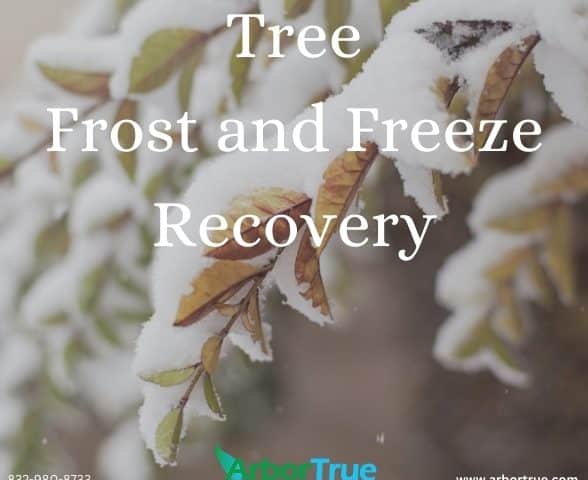
Mushroom Monday: Parasol Mushrooms
January 15, 2024
New Year’s Resolutions: Five Tips for Staying Motivated
January 17, 2024

Tree Frost and Freeze Recovery
Although you may have taken steps to protect your trees before cold temperatures arrive, trees can still experience stress and damage from frost and freezing. When the thermometer falls below freezing, and you see changes to your trees, you may be wondering what can be done to help them recover.
Don’t Panic
First, don’t panic. A lot can impact how a tree responds to cold temperatures and not all trees respond the same. Although your trees can be affected by cold and freezing temperatures, many may do just fine.
Depending on where you live and the types of trees you have, your trees may be hardy to your area. When a tree is hardy to an area, it generally means the tree can survive the average winter temperatures there. If your trees are hardy to your area, they might do fine during winter.
In addition to hardiness, if a tree is native to your area and established, it could have a better chance of surviving cold temperatures than one that isn’t. Also, trees with thicker bark and those with larger diameter trunks could do better during a freeze than those with thinner bark and smaller diameters.
In addition, keep in mind that trees have various traits that help them deal with the cold. For example, trees can begin to change as the season changes and light levels and temperatures fall. This gradual acclimation can help them survive in winter. As another example, tree bark helps insulate trees and can provide some protection from the cold. Also, trees have different types of leaves and responses to cold that help them deal with lower temperatures. Deciduous trees lose their leaves during winter (it helps prevent the loss of water and helps prevent damage to leaves from water expanding as it freezes), and evergreen trees have special adaptations that help them deal with the cold (for example, waxy coating on their needles that help retain water and antifreeze-like chemicals that can prevent water in their tissues from freezing). Additionally, in colder months, nutrients in deciduous trees can move to their roots where they can be retained during winter.
Another thing to keep in mind is that although parts of a tree might sustain damage from a freeze, damage to tree roots can be less common. Established trees with strong root systems can have a better chance of surviving a freeze even if parts of the tree get damaged.
Also, if you took steps before the frost and freeze arrived, you may have provided the extra protection your trees need.
Lastly, remember that damage after a freeze can sometimes look worse than it actually is. Trees can have an ability to recover. It is possible a tree that looks bad after a freeze, might look fine in the spring. In some cases, the best course of action might be to pause and assess the condition of your trees at a later time. For example, you might wait until temperatures warm in the spring and growth starts before having your trees pruned after a freeze. Once growth starts in the spring, the dead and living parts of a tree might be better assessed, and pruning could be more effective.
Some Trees Might Not Do Well in a Freeze
Although you shouldn’t panic, it is also important to keep in mind that some trees and other plants might not do well during a freeze. For example, viburnums, redbuds, and various palms might suffer stress and damage during a freeze. If you have trees that are not native to your area, not hardy to your area, have thin bark, or have small diameters, they might be damaged by a freeze.
Additionally, trees in pots that weren’t moved inside could also suffer during a freeze because of the low relative volume of soil in pots. Less soil can mean potted trees might not have as much protection for their roots during a freeze as trees planted in the ground.
Freezing can damage trees, because as water freezes it turns into ice. As this happens, the ice takes up a larger volume than the water it came from, and the expanding ice can damage plant tissue. This can also cause dehydration in a plant as the water is frozen and not available.
Although only a qualified arborist can assess a tree’s health and determine its condition after a freeze, there are some signs of freeze and frost damage that you might see.
For example, four to eight weeks after a freeze, the bark of certain trees might have cracks. This could be a sign that water froze inside the trunk of the tree and then expanded causing cracks. Cracks can also be caused if temperatures fall quickly. When temperatures quickly fall, the bark of a tree can cool quickly, and this can cause it to contract and crack. Later, you might see calluses on trees that had cracks after they healed after freeze damage.
On palms, the trunks might have spots of moisture. This is something that will appear right away after a freeze. It can be caused by the death of cells in the palm that results in fluid leaking into the trunk. While this might look bad, it might not be an indication that the entire palm died, but rather that a portion of the trunk suffered damage.
Have an Arborist Consultation
Certified arborists can assess your trees and palms after a freeze and provide you with information about their condition and steps that could be taken for their recovery and care. For example, an arborist can provide recommendations to limit infections from fungus and can take steps to help new fronds grow out on palms.
An arborist might make a number of recommendations such as fertilization, fertilization that includes potassium (which can help release starches in roots), applications of seaweed, and applications of something like ArborTrue Bio. An arborist might also recommend watering a tree after a freeze has occurred to help with dehydration and shock. Recommendations will vary depending on your trees, their conditions, and the severity of the freeze.
An arborist can also make recommendations for which trees might need to be removed after a freeze and they can develop a plan for planting new ones once danger of freezing has passed.
If you are concerned about your trees after a freeze, give us a call at 832-980-8733. You can schedule an arborist consultation where they can assess your trees and develop a plan for their care.



